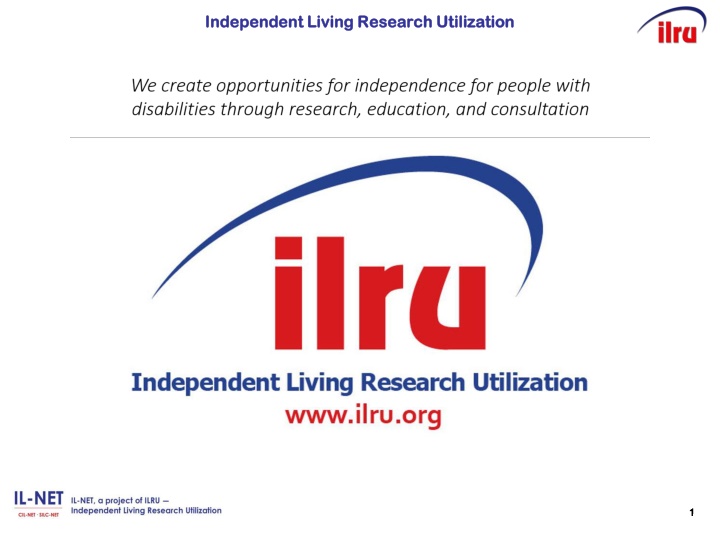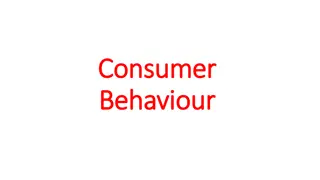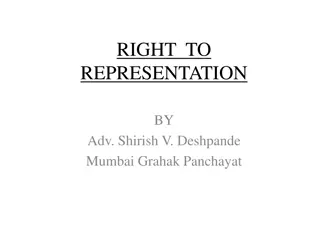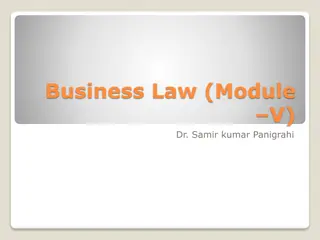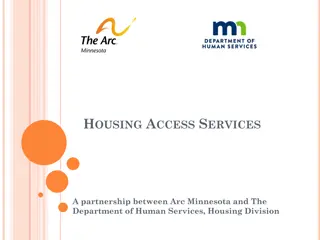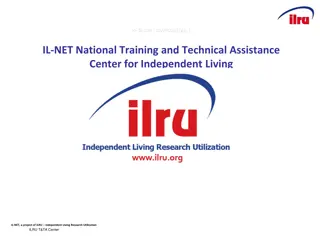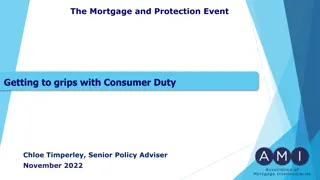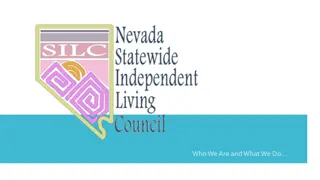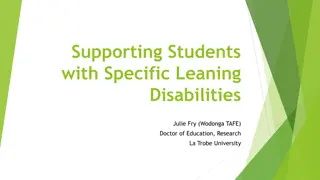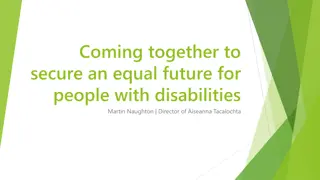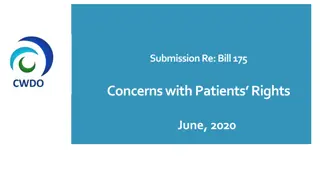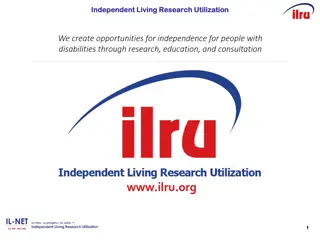Empowering Individuals with Disabilities through Consumer Control in Independent Living Research Utilization
Discover the core principles of independent living research utilization, emphasizing consumer control, peer support, and self-determination for individuals with disabilities. Learn about the Rehabilitation Act's focus on promoting integration and full inclusion, and the importance of having more than 50% representation of people with disabilities in key roles within Centers for Independent Living. Understand the definition of an individual with a disability under the Act.
Download Presentation

Please find below an Image/Link to download the presentation.
The content on the website is provided AS IS for your information and personal use only. It may not be sold, licensed, or shared on other websites without obtaining consent from the author.If you encounter any issues during the download, it is possible that the publisher has removed the file from their server.
You are allowed to download the files provided on this website for personal or commercial use, subject to the condition that they are used lawfully. All files are the property of their respective owners.
The content on the website is provided AS IS for your information and personal use only. It may not be sold, licensed, or shared on other websites without obtaining consent from the author.
E N D
Presentation Transcript
Independent Living Research Utilization Independent Living Research Utilization 1 1
Get to the Core of It: Get to the Core of It: Integrating CIL Core Services for a Integrating CIL Core Services for a Holistic Consumer Experience Holistic Consumer Experience Implementing or Strengthening Effective Implementing or Strengthening Effective Individual and Systems Advocacy Activities Individual and Systems Advocacy Activities Presenters: Presenters: Bruce Darling Bruce Darling Kimberly Tissot Kimberly Tissot May 2, 2018 May 2, 2018 Tempe, AZ Tempe, AZ 2
The Rehabilitation Act, as amended, Content Title I Vocational Rehabilitation Services Title II Research & Training Title III Professional Development & Special Projects Title IV Nat l Council on Disability Title V Rights & Advocacy Title VI Employment Opportunities Title VII Independent Living Services and Centers for Independent Living Only Title VII emphasizes consumer control as part of the foundation and philosophy of the funding. 3
Notice that IL Philosophy is first in the law! Consumer control Peer support Self-help and self-determination Equal access Individual and system advocacy Maximizing leadership, empowerment, independence, and productivity of individuals with disabilities Promoting integration & full inclusion of individuals with disabilities into the mainstream of American society...by funding the statewide IL network & centers. 4
What is Consumer Control? More than 50% of the board of a CIL must be people with significant disabilities. More than 50% of the management of a center must be people with disabilities. More than 50% of the staff of a center (not including attendants if you hire them) must be people with disabilities. More than 50% of the members of the SILC must be people with disabilities who do not work for either the State (in any agency or capacity) or a CIL. 5
1329.4 Definitions. Individual with a disability Individual with a disability means an individual who 1. Has a physical or mental impairment that substantially limits one or more major life activities of such individual; 2. Has a record of such an impairment; or 3. Is regarded as having such an impairment, as described in the Americans with Disabilities Act of 1990 (42 U.S.C. 12102). 6
1329.4 Definitions. Individual with a significant disability Individual with a significant disability means an individual with a severe physical or mental impairment whose ability to function independently in the family or community or whose ability to obtain, maintain, or advance in employment is substantially limited and for whom the delivery of independent living services will improve the ability to function, continue functioning, or move toward functioning independently in the family or community or to continue in employment, respectively. 7
Philosophy of Equal Access The expectation is that all operations of the IL Network are accessible. Your policy might include: Communication interpreters, readers, video, CART, captions, Braille and other alternative formats as needed for reasonable accommodations. Physical access to all sites used by the Council for meetings or for input. 8
Philosophy of Equal Access, contd. Notice regarding fragrance & smoke-free meetings to accommodate people with environmental illness/multiple chemical sensitivity and adherence by Council members. Signage for public areas meets ADA requirements for height, raised letter and Braille. Advocacy to achieve public access. 9
Advocacy Advocacy is a planned action to support an issue, interest, cause, or idea. Advocacy addresses a power inequality. Advocates must be aware of the constitutional rights of people with disabilities and assert them. 10
Individual Advocacy Addresses issues and needs identified by the consumer. Listen to the consumer. Hear what is being said and not said. Be willing to listen more than once. Don t be surprised if different information is given each time you listen. Individual Advocacy issues and barriers inform Systems Advocacy efforts. Connect the dots. 11
Role of the IL Advocate Role of the IL Advocate Gather all the facts from all parties involved be non-judgmental. Identify approaches to address the problem and assist the consumer with sorting through the options. Provide information and support the consumer towards personal empowerment. 12
Role of the IL Advocate, Role of the IL Advocate, cont d. cont d. Provide referrals and linkages to other options and expertise. Teach self-advocacy skills as you work with the individual. Follow the consumers lead as to how much assistance is needed. 13
Role of the IL Advocate, Role of the IL Advocate, cont d. 2 cont d. 2 Provide an objective insight to the situation. Provide mediation resources and negotiate on consumer s behalf if requested. Create a partnership so the consumer never feels alone in the process. 14
Breaking through Bureaucratic Breaking through Bureaucratic Barriers Barriers Never take "no" as the answer. Document everything! (It protects you, the Center, and the consumer.) 15
Why do Systems Advocacy? Why do Systems Advocacy? Aside from it being a required core function of Centers... If we do not fight for our own rights, no one else will. We have the obligation to make this world better for others. (At least we think so.) We have the privilege to be the voice of many who cannot, yet, be their own. 16
Framing is Everything When I started in Independent Living... Our IL Advocate would talk about the conflict between service delivery and systems advocacy, questioning which he should do. When I began working for a children's advocacy organization... Our Executive Director explained that we did individual advocacy (a form of service delivery) to inform our systems advocacy. 17
Effective Systems Advocacy and Effective Systems Advocacy and Direct Services are Interdependent Direct Services are Interdependent Direct services identify the barriers and systems; advocacy removes them. Service delivery can... Help identify people who can make the case for change. Frame individual issues in terms of systems bias which underscores that the problem is in the environment not the person. Support individuals in joining systems advocacy efforts to empower them. 18
The Pitchfork of Advocacy The Pitchfork of Advocacy Public Education / Media Legislative Advocacy Judicial Process Executive / Administrative Direct Action - from Bob Kafka All of these prongs are necessary at one time or another to bring about change. 19
Putting the Pitchfork into Action Putting the Pitchfork into Action Identify the issue. Set goals. Develop strategies (which prong(s) of the pitchfork is/are most appropriate for the situation?) Celebrate (even the small) victories. 20
Lobbying Lobbying CILs can NOT lobby with Subchapter B & C or any other federal funding. CILs (non-profits) CAN lobby with unrestricted, non- federal funding. 21
Your Certification Regarding Lobbying form promises you are not. . . Improperly influencing activities re: obtaining grants, contracts, cooperative agreements or loans. Attempting to improperly influence employee or officer of Government. Attempting to influence outcomes of federal, state, or local elections, referendums, or initiatives through in- kind or cash contributions, endorsements, or publicity. 22
You are not. . ., contd. Contributing to expenses of a political party, campaign, or political action committee. Attempting to influence votes for or against specific legislation with certain exceptions. Keep the form on file. 23
More about Lobbying What IS Allowed with Federal Funding Technical and factual presentations on topics directly related to the performance of a grant, contract, or other agreement in response to a documented request. Information must be readily obtainable and readily put in deliverable form. Costs of travel, lodging, or meals are allowed when incurred to offer testimony at a regularly scheduled hearing pursuant to a written request. Lobbying within limits set by the IRS related to your non-profit status, as long as you don t use federal funds. 24
Able SCs Lobbying Activities* Able SC s Lobbying Activities* Contracts with a Legislative Liaison/Registered Lobbyist ED and Lobbyist meet together with representatives Writes and advocates for bill to pass Testifies in support/opposition of a bill Provides guidance to state agencies regarding passed legislation Reports to the Ethics Commission every six months Spreads IL and disability rights throughout the SC general assembly Funding requests *Not using federal funds. 25
Careful Considerations when Lobbying Careful Considerations when Lobbying Check with your state laws regarding lobbying. You may need to register at your State s Ethics Commission and report often about lobbying activities. Register as a lobbyist. Document lobbying activities in your database system, timesheet, mileage, receipts, etc. 26
Careful Considerations when Careful Considerations when Lobbying Lobbying, cont d. , cont d. Plan & prepare to show documentation of lobbying activities. You will need to show that you are using funding other than federal. Lobbying should not constitute a substantial percentage of an organization s activities (IRS rule). IRS restricts organizations from using a substantial percentage of time, staff, and resources on lobbying. More information about what constitutes substantial is available here: https://www.irs. gov/charities-non-profits/measuring- lobbyingsubstantial-part-test. 27
Advocate to Remove Barriers! Advocate to Remove Barriers! 28
Community Organizing/Direct Action: Community Organizing/Direct Action: It s all about POWER! It s all about POWER! Power concedes nothing without a demand. ~ Frederick Douglass Power never takes a step back, except in the face of more power. ~ Malcolm X There are many different types of power, but for us... People = Power! 29
Community Organizing as an Element of Independent Living Community Organizing as contrasted with the Social Work/Helper model is consistent with Independent Living Philosophy. The locus of the problem is the environment/society. The solution is changing the external not the disabled individual. The solution is not secured by professionals, but through self advocacy. When addressing an issue as a Community Organizer, we work with groups of people, instead of individuals. 30
Direct Action More than Civil Disobedience Although people always think about civil disobedience, there are many different forms of Direct Action: Delivering declarations by organizations or petitions Distributing leaflets Picketing Bird-dogging, "haunting" or taunting officials Holding vigils, mock funerals and marches Doing street theatre Holding teach-ins, walk-outs, or sit-ins Overloading of facilities or administrative systems 31
Centers CAN Support Direct Action Systems advocacy is a core service. Free speech is protected by the Constitution. It was the FIRST Amendment for a reason. Centers can provide in-kind support (like space to meet) to other groups within the disability community who engage in direct action, including civil disobedience. Centers should establish policies that promote our movement and protect the Center. 32
Centers SHOULD Support Direct Action Direct Action is transformative; it shows people who may not have seen themselves as having power that they are in fact powerful. Everyone has something they can contribute to doing Direct Action. It bolsters the other forms of advocacy within the pitchfork model. It WORKS, and it s FUN! 33
A Good Systems Advocacy Issue A Good Systems Advocacy Issue Meets Most of These Criteria Meets Most of These Criteria Result in real improvement. Give people a sense of their own power. Alter the relations of power. Be winnable. Be worthwhile. 34
A Good Systems Advocacy Issue A Good Systems Advocacy Issue Meets Most of These Criteria Meets Most of These Criteria, cont d. , cont d. Be widely felt. Be deeply felt. Be easy to understand. Have a clear target. Have a clear time frame that works. 35
A Good Systems Advocacy Issue A Good Systems Advocacy Issue Meets Most of These Criteria Meets Most of These Criteria, cont d. 2 , cont d. 2 Be non-divisive. Build leadership. Lay groundwork for next campaign. Be consistent with your values. - from Organizing for Social Change 36
Some Other Tips to Remember Some Other Tips to Remember Anyone can be a leader. Invest people by using their strengths. The most important victory is the group itself. Leverage our perceived weaknesses as strengths. Never doubt that a small group of thoughtful, committed citizens can change the world. Indeed, it is the only thing that ever has. ~ Margaret Meade 37
Advocacy Resources Advocacy Resources Updating Your Policies to Match Current Financial Regulations, Module 15: Lobbying or Advocacy? (recorded video module) - http://www.ilru.org/training/updating- your-policies-match-new-regulations Systems Advocacy in CILs and Individual Advocacy in CILs (RapidCourse tutorials) - http://www.ilru.org/training/core-services-for-centers-for- independent-living-series Get to the Core of It: Best Practices in CIL Core Services Systems Advocacy (recorded webinar) - http://www.ilru.org/training/get-core-it-best-practices-cil- core-services-systems-advocacy 38
CIL CIL- -NET Attribution NET Attribution Support for development of this technical assistance information was provided by the Department of Health and Human Services, Administration for Community Living under grant number 90ILTA0001. No official endorsement of the Department of Health and Human Services should be inferred. Permission is granted for duplication of any portion of this information, providing that the following credit is given to the project: Developed as part of the CIL-NET, a project of the IL- NET, an ILRU/NCIL/APRIL/USU-CPD National Training and Technical Assistance Program. 40
